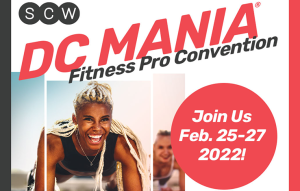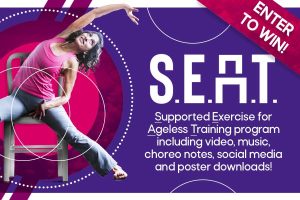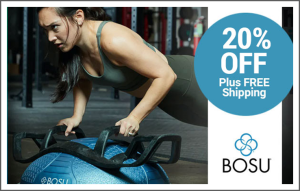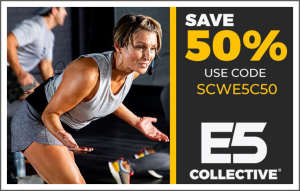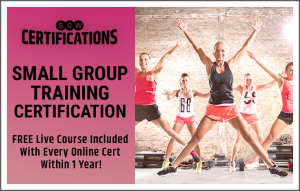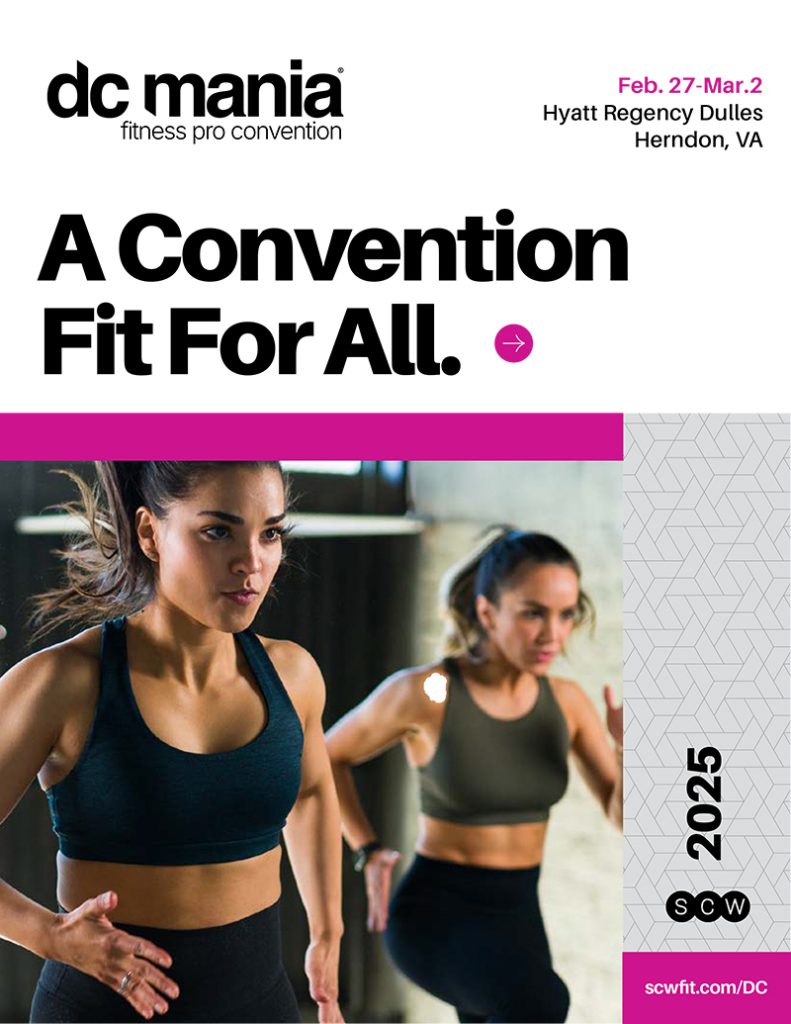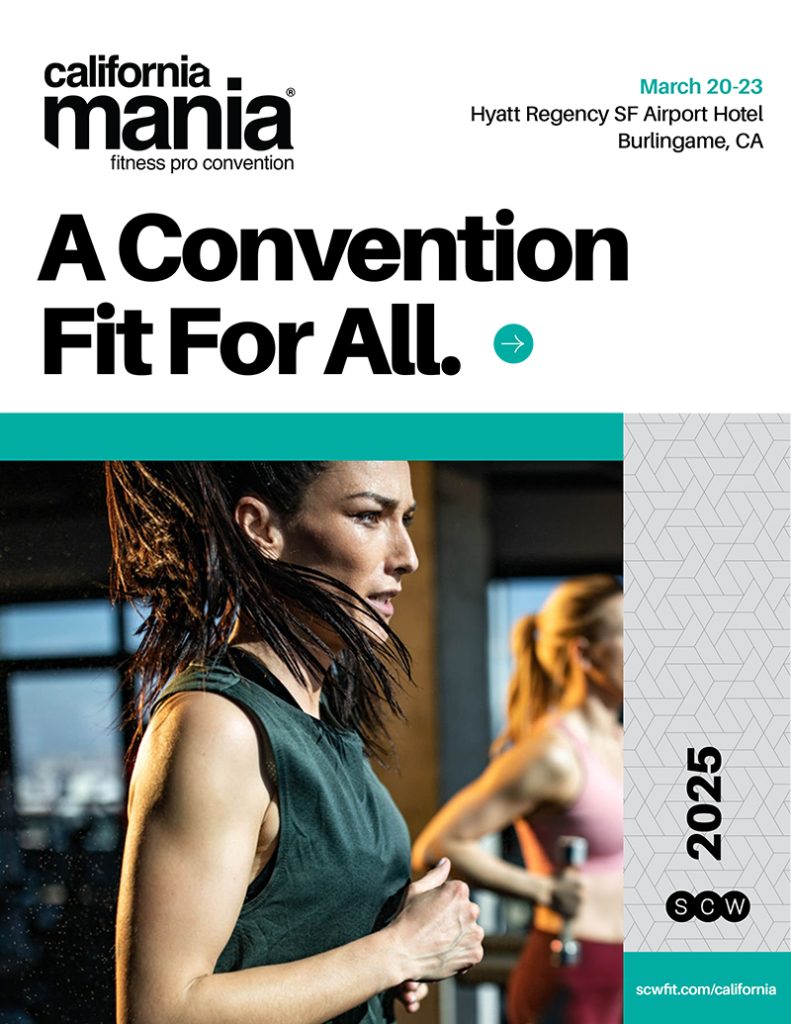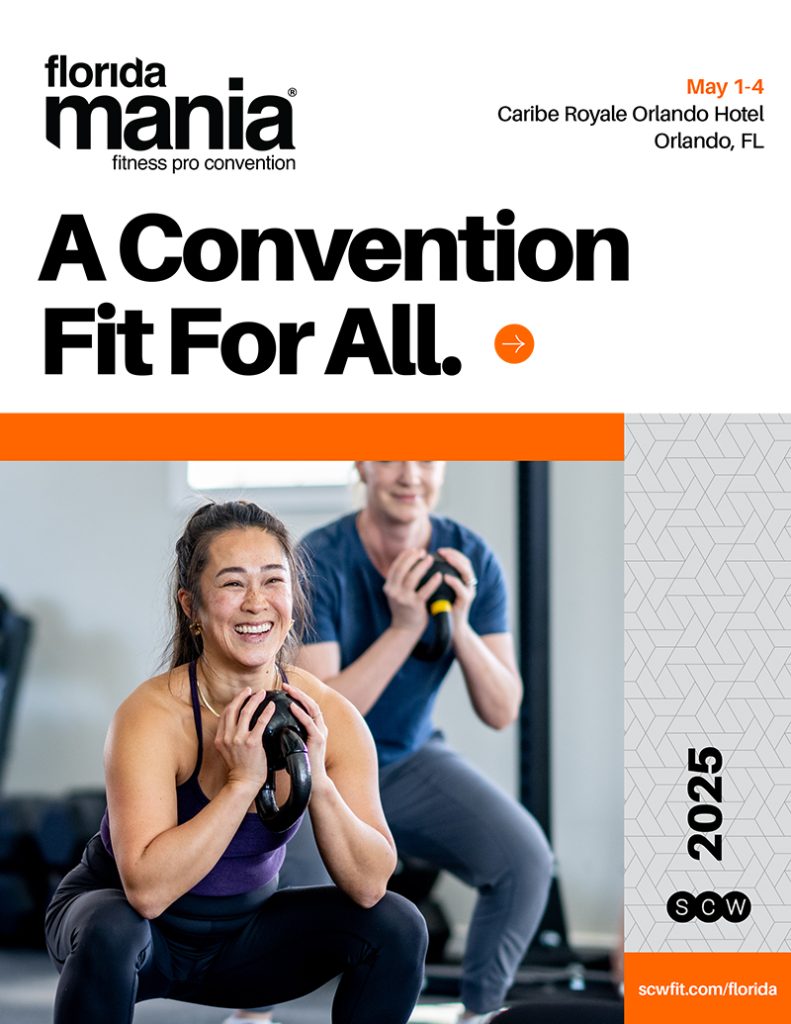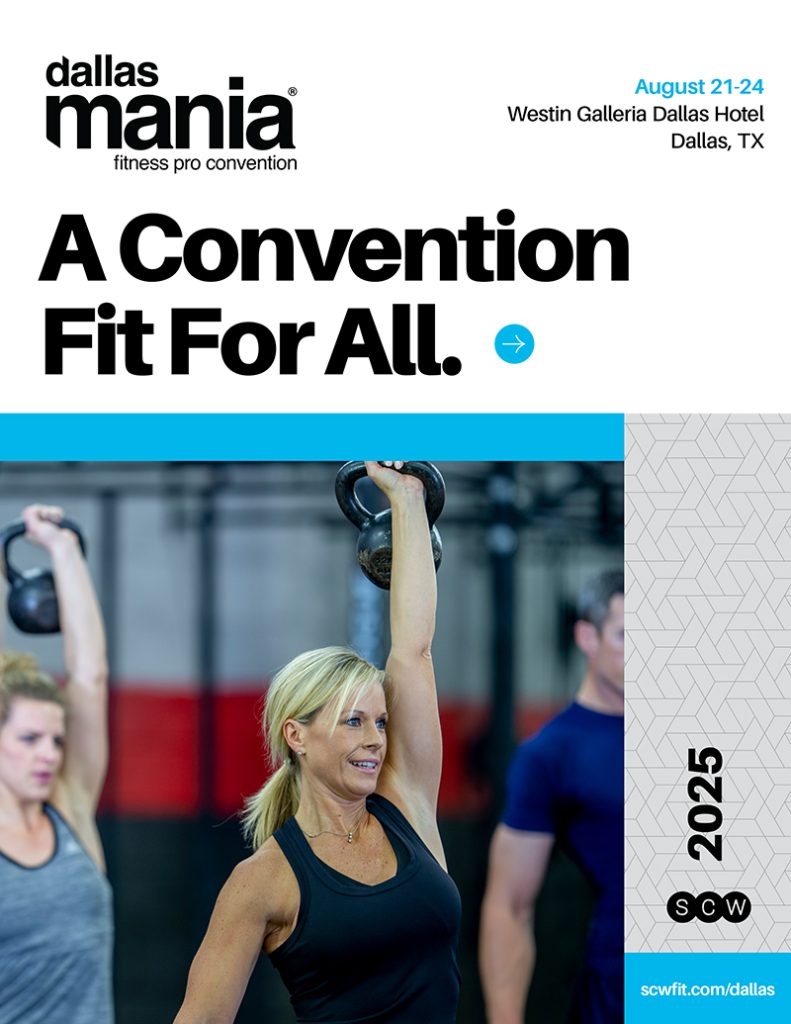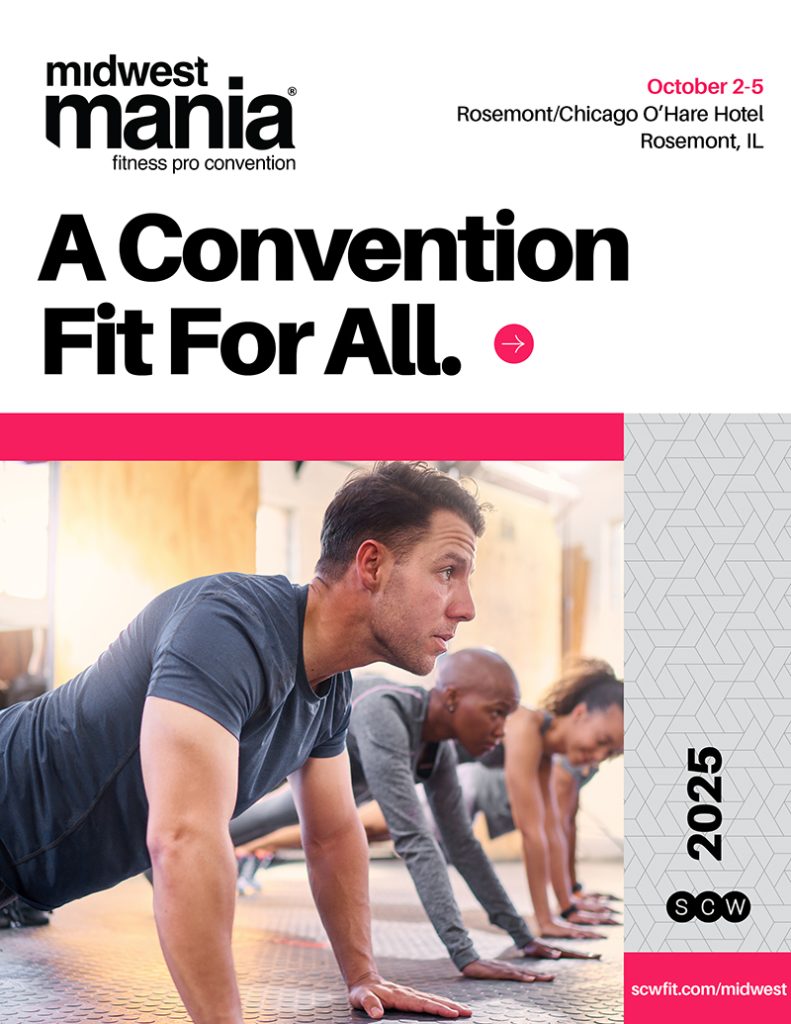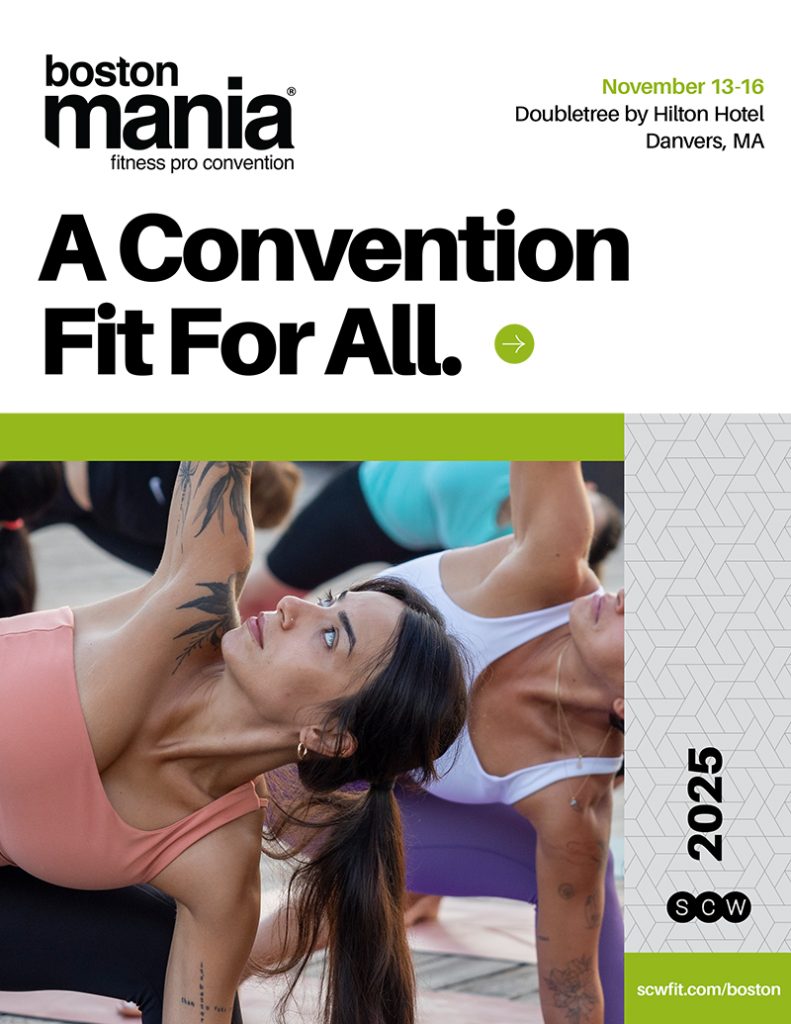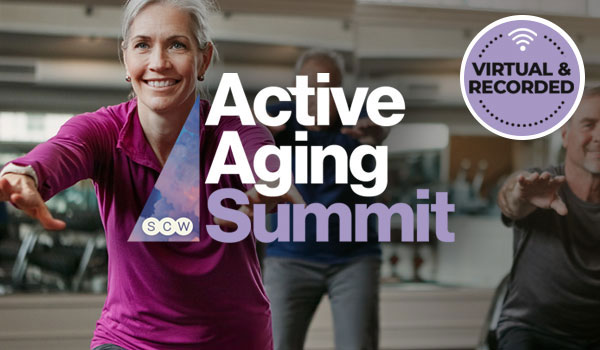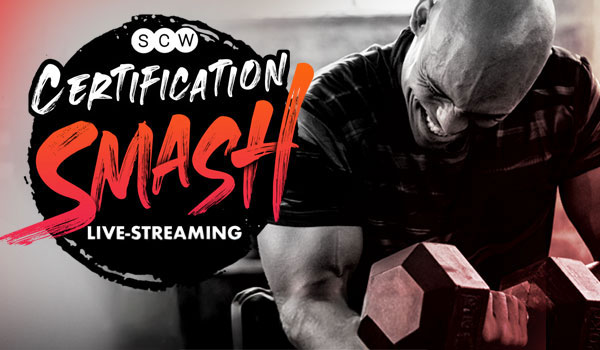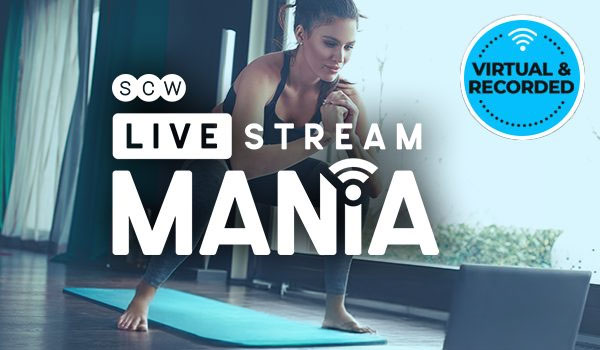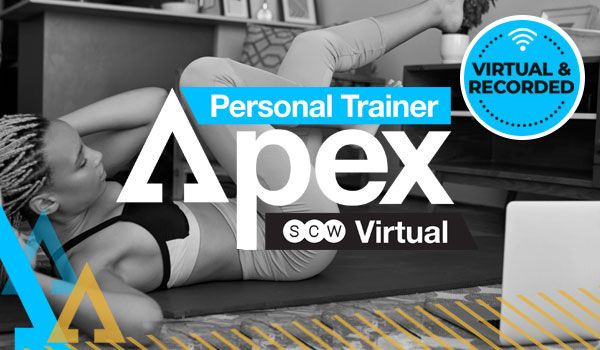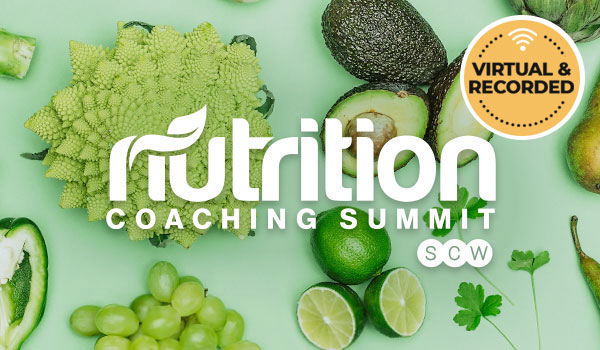
SCW Spotlite: Issue 41

IHRSA’s New Membership Tiers Fuel Industry Advocacy, Outreach & Career Growth
Studios and individual professionals are now eligible to join IHRSA!
by Nicole Johnson
Membership has its privileges, according to a familiar slogan, and membership in IHRSA, the health and fitness industry’s premier association, has proven its worth to the global fitness community—especially in the last 20 months.
With so much at stake, IHRSA leaders decided that the organization is stronger with more inclusivity and unity. As a result, IHRSA had introduced flexible, tiered membership options that expands eligibility to individuals and studio facilities. Further, IHRSA will devote a portion of dues to fund advocacy and public affairs.
The new membership options include:
- Basic: This level is ideal for companies that want to engage with industry best practices, resources, and experts. Operators will have access to management tools and industry insights to recover, innovate, and grow their business while expanding their voice and becoming more active in public affairs.
- Standard: Equivalent to the existing club membership, this level is designed for operators who want to grow their business, develop skills, train staff, and contribute to the industry. Operators can expect diverse insight, data-driven research, and effective tactics to curate stronger industry relationships and help build their business. (Current members will transition to the Standard Club Membership and enjoy added benefits.)
- Premium: This level includes executive insight, priority service, exclusive networking, and greater brand recognition. Operators will participate in increased engagement with IHRSA and the global industry, including updates and access to public affairs matters and public relations regarding the image of the industry. To date, nearly 100 club companies have chosen to upgrade to Premium membership since its introduction only a few months ago.
“The new tiered membership allows IHRSA members to engage with the fitness industry at a level of their choosing, and which fits their needs best,” says Alan Leach, IHRSA board chairman and CEO for West Wood Club in Dublin, Ireland. “At a time when uniting the industry has become so important, the additional membership options provide a voice to sectors of the industry that weren’t previously represented.”
IHRSA has also added a Studio Membership and Professional Membership to make it easier for health and fitness professionals to be more involved with IHRSA.
“The goal of the tiered membership structure and additional membership options is to provide services to virtually any professional or business in the health and fitness industry,” says Nicole Johnson, IHRSA’s US Director of Club Membership. “It is our hope that more clubs, studios, and industry professionals will join IHRSA to become more active with advocacy and expand the voice of the industry. Supporting IHRSA through membership not only supports your business and the industry, it is the right thing to do.”
For U.S. members, a portion of their dues will go toward public affairs the National Health & Fitness Alliance (NHFA), while international members will contribute to the Global Health & Fitness Alliance (GHFA). In addition, IHRSA pledges to donate 1% of its total annual revenues to the IHRSA Foundation to promote health through exercise.
For more information on the new membership tiers take a moment to watch this short video and go to www.ihrsa.org to read more or contact Nicole Johnson directly at nj@ihrsa.org.
 Author, Nicole Johnson – Director of US Club Membership
Author, Nicole Johnson – Director of US Club Membership
Nicole has lead the US membership team of up to six for ten years. She is responsible for developing strategic plans to help generate awareness, increase club membership, and influence greater participation from health clubs members. She also develops effective campaigns that communicate the benefits of membership and improve member retention.

FIT FRIENDS GIFT TRENDS: Harness the Gift of Gratitude
by Ann Gilbert
Gratitude is more than just a feeling of thankfulness. It’s a readiness to show appreciation and in turn send a gift of kindness to those in need. The year’s “Fit Friend Gift Ideas” have evolved from what we found under the tree or at our doorstep just two years ago.
After having written a similar blog post in 2019, I can honestly say that the list of “Fit Friends Gift Trends” have evolved throughout the pandemic years. In 2019 we ran out to purchase electronic wearables to track steps, heart rates and efforts. We focused on intensity, accountability, and inner competition. This holiday season, our tracking is not only on the wrist, but on the finger and can access so much more, like health status, recovery %, sleep patterns and even predict an oncoming cold or fever.
With eco-friendly and global warming as popular topics, we have moved away from gifting plastic water bottles, with many finding reusable glass under the tree. Our fit friends will celebrate ounces downed along with reading positive encouragements printed directly on the bottles.
Just a few years ago, yoga mats were branded, rectangular and colorful. Today they resemble “ongoing” in new round versions which are basically works of art and can even be purchased in heated versions. These mats show flexibility and wiliness to a adjust for others which many feel is the ultimate form of appreciation.
We loved going out for our massages and facials, purchased with certificates and delivered through snail mail. But now, masks, hand sanitizer and “no touch” guide our days, driving, trendy percussion guns to target fascia and fatigue in the comfort of our safe, protective homes. As this year’s recovery tool of choice, one will find the ability to not only reduce soreness and release tight fascia, but to also stimulate the lymphatic system and detox at the deep cellular level.
Fitness Fanny packs show up as a classic gift that keeps re-emerging. Another necessary wardrobe item that sparks discussion are trendy running socks, which make great stocking stuffers. They now elevate a level to include compression and warming for both arms and legs, which can be found in most running stores.
Another option of gratitude might be to lean toward the mental desire more so than the physical. Wellness is both for the body and mind. We can make notations and write thoughts in our portable devices, but by putting pen to paper a sense of affirmation is fulfilled. This strong word helps guide our minds to stay focused and aware. Fitness journals provide a simple way to make these thoughts into notes to refer to in the future. Reminders, like placing simple words, “I am”, “I plan to”, and “I will” as top entries help keep us centered. Experts find the act of writing is the key to success, unlike hearing it from your watch or wearable. Today’s journals include meal planning options, goal setting equations and a place to document daily celebrations.
One last trend for the 2021 holiday season includes gifting Behavior Coaching Services along with Boutique Fitness Studio Packages. These complimenting services are perfect for the person who just needs a little extra TLC. Having one-on-one time with a personal coach or small group trainer just might be the key to reaching a fitness goal. A positive outcome of the pandemic is a real focus on wellness and behavior change. We find that the scale is not as popular as is the assessment of how many N.E.A.T (non-exercise activity thermogenesis) activities were accomplished in a week’s time. Coaches discuss true behavior change that include socialization, functional activities in and around the home, as well as really looking at nutrition to increase or transfer to enhanced activities of daily life for all ages.
As the owner of two Shapes Fitness for Women franchises, SCW Faculty, Co-Founder and Choreographer of the new S.E.A.T. Chair Program, I wish you the merriest and happiest holiday season and a safe, healthy new year.
 About the Author, Ann Gilbert
About the Author, Ann Gilbert
Ann Gilbert is an owner of two Shapes Fitness for Women franchises and a sold-out International Presenter and is featured regularly in publications and on local TV. She is an SCW Faculty member leading a variety of certifications and is the Co-Founder and Choreographer for the innovative S.E.A.T. Chair Program, (Seated Exercise for Ageless Training). A WATERinMOTION® Master Trainer, Ann was awarded the ACE/IHRSA Personal Trainer of the Year award.

Creating a Well-Balanced Golf Fitness Plan
Part 1: Stability
by Carol L. Teteak, MS
Like prepping a golf bag for a successful round, the body should also be equipped to withstand the rigors of the sport before hitting the links. To help reduce the risk of injury and improve performance on (and off) the course, think S.M.A.R.T. – an acronym I use for Stability, Mobility and Reactive Training.
For the first part of this series, Stability Training will be briefly discussed along with its importance to the golf swing. Additionally provided are sample exercises to target 4 key areas of the body crucial to the swing phase that you can incorporate with your client’s routine right now!
S is for Stability
Joint stability allows proper support and control throughout movement (or motor tasks) while maintaining good posture¹. (NASM blog) Whether that task is easy, such as pulling a golf club out of a bag, or complex, like the explosiveness of a golf swing, we rely on our body to perform what we ask of it. There’s an impressive collaboration between our muscles, nerves and brain that facilitates how well we move. Referred to as our Neuromotor System, its function can be compromised if a joint lacks stability, which opens risk for injury². (MyTPI Articles) Your goal should be to help your client build and maintain a healthy body structure to allow appropriate range of motion, transfer of power and stamina throughout each swing.
Is Injury Par for the Course?
Golf injury should not be underestimated! Statistics show over 40% of amateur golfers will sustain a game-related injury each year and on average, forced to miss the action for up to a month³. (NIH) Although wrist, elbow, shoulder and low-back may be the most prone areas, hip and foot/ankle issues aren’t far behind.
Outside of a faulty grip or set up, what’s causing all the trauma? For the professional golfer, overuse is sighted as the #1 reason. While that may not be as common in the recreational & occasional golfer, I’ve found that both poor swing technique and inefficient movement patterns are more likely the result of muscle imbalance & weakness leading to an enormous amount of stress on the body and potential injury!
Swing into Action
Reducing the risk of injury can be accomplished through effective physical preparation and ideally assessing, then creating a program to meet the specific needs of a client is always recommended. However, incorporating a few familiar exercises into their weekly routine – with the addition of the BOSU® Balance Trainer for a unique approach – can help build a strong foundation to keep them in play as well as moving better throughout daily life activities.
Although the following sequences can be performed without the Balance Trainer…and may be preferred to those new to the tool…the labile surface provides an opportunity to improve joint stabilization both dynamically and comfortably. The base exercise and progressions are shown in each video to suit varying fitness levels.
Sets: 1-3 of each exercise
Repetitions: 3-12
Cadence: 2-3 times per week
Notes: Can be performed as an independent sequence or added to current routine; gradually increase sets and reps as endurance & strength improves
Legend: BT = Balance Trainer
#1 Foot & Ankle: Weight Shift with Balance Challenge Transfer of power throughout the swing begins at the foot & ankle then travels up through the kinetic lines. The unpredictability of the BOSU® BT, alternated with the fixed surface of the floor, challenge the stabilizer muscles of this complex differently to help build a strong & adaptable base of support.
- Begin with one foot on dome of BT and the other on floor in line with the first
- Perform a squat to your comfortable depth while simultaneously shifting weight from foot on floor to foot on dome
- Progression #1 – Add 1-leg balance with opposite foot maintaining contact on dome only
- Progression #2 – Remove contact foot on dome and add 1-leg balance with squat on floor as well
#2 Hip Complex: Kneeling Balance with Hip Hinge A strong lower body is crucial to providing ample power and speed for our golfers! This rare approach to unilateral strength immediately targets the muscles that stabilize, rotate, flex, and extend the hip to improve imbalances, increase strength and reduce sliding & swaying.
- Begin in half-kneeling position with one knee on top of dome & opposite foot on floor
- Weight evenly distributed between knee and shin on dome while allowing the same foot access to ground behind BT for contact point
- Slowly release front foot from floor and touch knee to side of dome
- Keeping head and spine straight, hinge at hips while reaching hands to floor; return to start and repeat
- Progression #1 – Remove contact point of kneeling leg foot on floor behind BT
- Progression #2 – Remove contact point of opposite knee to dome while hinging
- Progression #3 – Remove contact point of front foot to floor when returning to start
#3 Trunk: Dead Bug with Rotational Challenge Isometric exercises help improve muscular endurance by challenging time under tension. This variation of Dead Bug, with the added dynamic surface of the BOSU® BT, increases the demand of the core stabilizers enabling them to perform better throughout the swing phase.
- Find ‘sweet spot’ on top of dome where tailbone and back are supported, legs off floor with knees at 90° angle & arms reaching towards ceiling (like an upside-down table-top)
- To prevent body from conforming to arc of dome; gently press low back into dome, keep chin slightly tucked and upper body/shoulders lifted
- Hold position statically up to 1 minute
- Progression #1 – Add golf club in hands then rotate trunk to each side touching club end to floor
- Progression #2 – Reach further away with club end while rotating
#4 Shoulder Complex & Posture: Tripod Forearm Plank The shoulder is one of the more common injury prone joints in golf. Lack of stability in this complex can lead to unnecessary issues in surrounding joints as well as poor posture. Use of the BT here reduces stress on the wrist [of the ‘working’ arm] so the focus can stay on the gleno-humeral joint and scapulo-thoracic region.
- Begin in modified plank position on knees with one forearm in center of dome & opposite hand on floor next to BT
- Use an exercise mat under knees for cushion if needed
- Gently push forearm into dome and hold position statically for up to 1 minute
- Progression #1 – Briefly remove hand from floor while maintaining modified plank position; return and repeat as able
- Progression #2 – Extend body into full plank position and hold up to 1 minute
- Progression #3 – Briefly remove hand from floor in full plank position
Find the BOSU® Balance Trainer and a variety of functional training products at www.BOSU.com, then look out for Part 2 of Creating a Well-Balanced Golf Fitness Plan: Mobility coming soon!
 About the Author, Carol L. Teteak, M.S. – BOSU® Education Manager & Golf Fitness Specialist
About the Author, Carol L. Teteak, M.S. – BOSU® Education Manager & Golf Fitness Specialist
Carol uses her love of athletics and knowledge of the human body to drive her passion for helping others move better in life and sport. Armed with a Master’s in Exercise Science, ACE & NASM certifications, hundreds of continuing education hours in sport conditioning, 18 years of training golfers – and just as many working for BOSU® – she created a fitness-based program (aptly named GolfSMART) to improve performance & reduce the risk of injury for golfers. Originally offered locally through a hospital-based facility, she now enjoys virtual sessions that highlight all of the BOSU® products!

Get Your Game On
by Aimee Nicotera
Who doesn’t like to have a good time? I think it’s safe to say that all of us like to have fun and love to experience playful and enjoyable activities. Now, we might each have our own idea of what “a good time” looks like, but in general, having FUN is a good thing.
It has been said that play is an essential trait of developmental success “…and one of the strongest drivers of human behavior.” (Sintek et al. 2013) The literature also suggests “when clients enjoy their training, they are more likely to make it a habit…” (Jett at al. 2013) This begs the question, is there value in creating fun, playful training sessions for clients of all ages? Yes! Consider several easy strategies for creating playful opportunities with one-on-one training sessions, small group sessions and even large group classes.
- Get involved as the coach! While it may take a bit more energy and attention, actively engaging in an exercise activity or drill with a client can definitely spice things up. Students often a get a kick out of seeing their trainer sweat, mess up or simply exert some effort.
Specific examples include:
- Throwing drills with a medicine ball – The coach plays catch with the client, changing the direction each person is facing, the body position when throwing and catching, and the style of pass executed.
- Mirroring drills with a dumbbell – The coach keeps quiet while moving with a dumbbell. The client faces the coach and mirrors every move they make.
- “Ladder drills” – The coach and client take turns doing repetitions, each executing 1 more than the other person just performed.
- Make a game of it! Let’s talk about friendly competition. Games that allow participants to unite around a common goal or shared experience can become “…an emotional common ground and pathway” (Sintek et al. 2013). Group games or partner drills can quickly create a sense of accountability, shared responsibility and result in a support system lasting beyond the training session. Two ideas for game-like drills include:
- Partner sprints – One person sprints out and back, while the other partner recovers and cheers. The coach sets a time goal. Two minutes is a great place to start, as it is challenging but doable.
- Balloon “keep it up” – Partners play “keep it up” with each other, or the coach adds multiple balloons to a larger group working together. If the balloon touches the ground, then partners, or the whole group, perform a more challenging exercise selected by the coach.
- Engage the brain! Drills requiring the body to execute one task, while the mind is executing another task simultaneously, are great for boosting cognition function. (Gheysen et al. 2018) They can also be really fun! These drills can challenge reaction time, coordination, and more! Coaches can lead these types of drills with one client or with larger groups, in-person or virtually. Simple examples might include:
- Plank get-ups – A client or group holds a forearm plank. The coach calls out right or left, and participants respond by getting up, shuffling the appropriate direction, touching down with a hand, then returning to plank. The coach can add numbers, letters or other cues to indicate right or left to make things more interesting.
- Graffiti drill – A client holds a dumbbell with both hands in a low squat. The coach calls out a word. The client “writes” the word on an imaginary wall, as large as possible, then returns to start position.
E5 COLLECTIVE® is a fitness format that incorporates play and brain training in a unique way, making it easy for instructors to coach clients successfully. Watch this video for some fun Partner Sprint Drills as an innovative way to play.
Visit www.e5collective.com to learn how to become an E5 COLLECTIVE® team member, receive new programming monthly or simply participate in a training session.
Make it a point to add some PLAY into your training sessions! As health coaches, we are serious about our mission, and we want people to make moving a permanent component of their day and valued part of their lifestyle. If making things a bit more playful facilitates that, let’s do it!
 About the Author, Aimee Nicotera
About the Author, Aimee Nicotera
Aimee Nicotera is an international fitness presenter and Virtual Studio Owner with over 25 years of experience. She holds a BS in Nutrition Science, a master’s in health education, as well as numerous certifications, including those from ACSM, ACE and AFAA. Aimee has extensive experience developing programs, doing research, and delivering education. She is the creator of the fitness DVD series 2X2 Conditioning and Take 20!, as well as the format E5 COLLECTIVE.

Spend Less Time Planning Classes: The GXu Remix Formula
by Summer Sides MS, CSCS, RYT-200
Creating new workouts and class plans is fun but can be super time-consuming. So why not create one workout plan that you can do over and over with just small tweaks?
That’s right, all you need to do is create a base class and then mix it up by changing one of the class elements. Not only does this save you tons of planning time, but it also gives members a chance to practice and perfect their movement techniques. (Sounds like a win-win for sure!)
Get the most out of your class planning time with The GXu Remix Formula
- G (goal & guide): Set a goal using your planning guide
- X (exercises): Pick your exercises and craft your base class
- U (unlimited remixes): Create unlimited remixes by tweaking various class elements
While it might take you some time at first, once you get the hang of it, you’ll find that it makes your class planning life so much easier (and actually more fun).
Get Started creating your classes!
Go ahead, pull out your notebook and let’s dive into crafting your very own Remix Series!
First, think about your class goal.
It’s really true, all good classes start with a super-specific goal statement. You know, all about what you want people to get out of your class and how they’ll get there. A statement that actually gives direction and isn’t just “let’s get a good sweaty workout in.”
Craft your goal statement by identifying what to focus on for each of the seven elements of a class design.
- Training Focus (cardiovascular, resistance training, range of motion, mind-body)
- Drill Pattern (circuit, superset, AMRAP, EMOM, etc.)
- Frequency: how often (sets)
- Intensity: how hard
- Time: how many (reps)
- Equipment (pick 1-3 pieces)
- Music (background or driving force)
Armed with all this info, now you can write your class goal statement.
Secondly, you pick your exercises.
Your options are truly endless when it comes to picking exercises, and there’s lots of things to consider (like the format of your class, who’s in class, the space you have, and what you know how to coach super well.) But the top question to ask yourself is…
Will you focus on movement or muscle?
Here at GXunited we focus on movement pattern-based training and 11 different movement patterns. But that’s not the only way. If you love picking your exercises based on muscle groups – do it.
Simply pick 8-10 exercises that move in all planes of motion. Then throw these exercises into an Exercise Selection Chart – identifying the movement pattern, plane of motion, body position, and muscle groups involved.
Now, write your base class plan.
You’ve done all work, now you put it into action with your Base Class Plan.
Quick tips for crafting a good workout experience.
- Limit the time spent changing equipment.
- Consider the order of exercises and think about the “up and down” nature of transitions.
- Give appropriate rest periods based on the intensity and training focus.
There you have it. From a simple checklist to a full class plan, you’ve done it! Now we can craft a full library of remixes from that simple base class plan.
Mix it up with remixes.
To create remixes, all you do is change one (or two) class elements to give a whole new experience. For example, if your base class used dumbbells, switch to kettlebells. Nothing else in your class plan will change, but the workout will feel completely different. Maybe take a
class originally designed as 3 circuits and change it to 4 supersets. Again, nothing else in the workout changes, you just are left with an entirely different feeling workout.
In GXu Remix 1: Pure Strength – you’ll notice this is exactly what we did. We made these minor changes and kept everything else the same (including the warm-up and cool-down). When you experience the class (available on GXunited.TV), you’ll notice how different it feels, yet at the roots it’s the exact same.
Base Class | Remix | Element Changed |
Dumbbells | Kettlebells | Equipment |
3 Circuits | 5 Supersets | Drill Pattern |
Strength-endurance | Strength-power | Training Focus |
It really is that simple! When you have the foundations set and you know where you’re going, it really is easy to make shifts and create a full library of remixes in no time at all and once you
get a handle on this, your options really do become endless for crafting remixes. But we’ll save that for a later time.
For now, enjoy creating remixes based off your Base Class Plan and the 7 Class Elements 😊.
Happy Class Planning!
As an SCW Spotlite reader, you can save 20% on the purchase of the Gxu Remix Series 1. Use this bundle link: https://bit.ly/gxuremixseries1scw and this coupon code SCWGXUREMIX20. Learn more about GXu Remix Formula, GXu Remix Series 1, and Movement Patterns at www.GXunited.com or email me at Summer@gxunited.com.
 About the Author, Summer Sides MS, CSCS, RYT-200
About the Author, Summer Sides MS, CSCS, RYT-200
Summer is a bit of an exercise science and group fitness geek! In fact, she’s a professor of Exercise Science, Founder of GXunited, and Creator of CounterFlow Yoga. Over the past 20-years she’s taught almost all forms of group fitness, owned a Yoga Studio, and worked with companies such as NETA, Les Mills, IGNITE360, and ACE. She’s on a mission to empower the next generation of fitness professionals with solid movement pattern techniques and sport psychology principles.

Cheat Meals, Splurges, and Treats — Oh My!
(Recipe Included)
by Sohailla Digsby, RDN, LD, CPT
Do you ever have a “cheat day,” or an “I deserve this day” after a long, hard week? Or on a holiday?
As a fitness-based dietitian, I coach people who try really hard, and seem to be doing most everything right…but, if they are not seeing or feeling the results they are after, we usually discover that they tend to overdo it on the weekends, holidays, off a routine, or out of town. Many gym-goers invest in their club memberships, workout gear, and consistently exercise hard, JUST to work off their weekend- or special-occasion splurges.
I’m not saying there is not a time for indulging. I just want you to know the facts, so you can make an informed decision and savor any splurge slowly and strategically that you make. How a splurge is “defined” is up to you – it’s all about mindfulness. Most extra fat cells have come to be due to mindless splurges…subconsciously unnoticed by your brain. Your body, however, has no choice but to keep a record of excess calories in the form of fat tissue.
Thoroughly enjoying splurges is part of a full, rich life, but if they are not strategic, mindful splurges, they may throw you off course. Fried foods or chips, sweets, caloric beverages, processed “snack foods,” chocolate, alcoholic beverages, or pizza are all examples of splurges. These can fit into your healthy lifestyle if you are self-aware and balanced.
What about when you deserve a treat? I recommend people reward themselves with wellness-promoting, non-food items like massages, invigorating getaways, or new fitness gear…and enjoy strategic food splurges instead of “cheat days” or “cheat meals.”
Make a decisive decision regarding how many surplus calories you can “afford” for each week. Think of it like a weekly budget…when it’s gone, it’s gone! Enjoy “spending” it on what you want most. Decide in advance what it will be and set yourself up to savor each bite or sip, mindful of your portion-sizes, as well as the enjoyment.
No one wants to endure the regret of careless (“did I really just eat that?”) munching, binging, or remorse-inducing choices. Resist the mindset of restriction, instead enjoying the freedom of having goodies to savor, while still preserving your health and confidence. If you need guidance, reach out to a wellness-based dietitian for support.
As an added bonus, here’s a little treat guaranteed to not make you repent your splurge and maybe even share with your friends and family (but don’t tell them your little secret.)
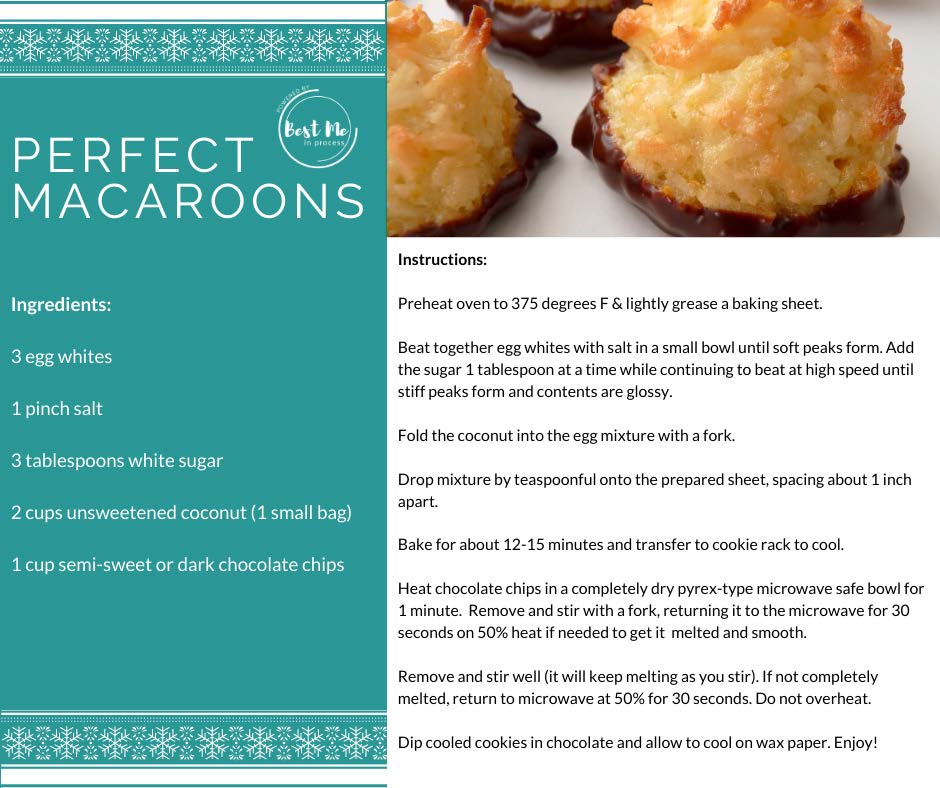
 About the Author, Sohailla Digsby, RDN, LD, CPT
About the Author, Sohailla Digsby, RDN, LD, CPT
Sohailla Digsby is a registered dietitian, author, and the developer of the life-changing 52-day Best Body Countdown program for gyms to use to provide the missing piece of the fitness puzzle: nutrition with accountability. With over 20 years of experience as a fitness pro and RD, Sohailla provides nutrition coaching, and runs an online membership-based group that’s not just about the weight you lose, but the life you gain! She has authored three books to help fitness professionals guide their clients to their goals and maintain their Best Bodies.
 We’re always looking for great content highlighting the newest things in the world of fitness. Please submit your article directly to editor@scwfit.com for immediate consideration!
We’re always looking for great content highlighting the newest things in the world of fitness. Please submit your article directly to editor@scwfit.com for immediate consideration! Spotlite, April 9, 2025
Spotlite, January 5, 2025
Spotlite, November 11, 2024
Spotlite, September 27, 2024
Spotlite, August 31, 2024
Spotlite, July 26, 2024
Spotlite, June 22, 2024
Spotlite, May 23, 2024
Spotlite, April 26, 2024
Spotlite, March 22, 2024
Spotlite, February 19, 2024
Spotlite, January 20, 2024
Spotlite, December 21, 2023
Spotlite, November 18, 2023
Spotlite, October 22, 2023
Spotlite, September 21, 2023
Spotlite, August 19, 2023
Spotlite, July 19, 2023
Spotlite, June 19, 2023
Spotlite, May 18, 2023
Spotlite, April 21, 2023
Spotlite, March 28, 2023
Spotlite, February 18, 2023
Spotlite, January 21, 2023
Spotlite, December 16, 2022
Spotlite, November 19, 2022
Spotlite, October 22, 2022
Spotlite, September 24, 2022
Spotlite, August 23, 2022
Spotlite, July 22, 2022
Spotlite, June 20, 2022
Spotlite, May 18, 2022
Spotlite, April 20, 2022
Spotlite, March 25, 2022
Spotlite, February 17, 2022
Spotlite, January 14, 2022
Spotlite, December 17, 2021
Spotlite, November 18, 2021
Spotlite, October 25, 2021
Spotlite, September 16, 2021
Spotlite, August 9, 2021
Spotlite, July 10, 2021
Spotlite, June 8, 2021
Spotlite, May 14, 2021
Spotlite, April 30, 2021
Spotlite, March 30, 2021
Spotlite, February 23, 2021
Spotlite, January 20, 2021
Hyatt Regency Dulles
Herndon, VA
Hyatt Regency SF Airport
Burlingame, CA
Caribe Royale Orlando
Orlando, FL
May 1-4, 2025
May 2026
Grand Hyatt Atlanta Buckhead
Atlanta, GA
July 24-27, 2025
July 2026
Westin Galleria Dallas
Dallas, TX
August 21-24, 2025
August 28-30 2026
Rosemont Chicago O’Hare
Rosemont, IL
Oct. 2-5, 2025
Oct. 2-4 2026
Doubletree by Hilton
Danvers, MA
Nov. 13-16, 2025
Nov. 13-15, 2026



